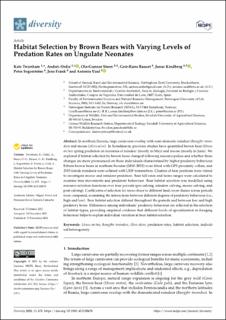| dc.contributor.author | Twynham, Kate | |
| dc.contributor.author | Ordiz, Andres | |
| dc.contributor.author | Støen, Ole-Gunnar | |
| dc.contributor.author | Rauset, Geir Rune | |
| dc.contributor.author | Kindberg, Jonas | |
| dc.contributor.author | Segerström, Peter | |
| dc.contributor.author | Frank, Jens | |
| dc.contributor.author | Uzal, Antonio | |
| dc.date.accessioned | 2022-03-17T13:43:39Z | |
| dc.date.available | 2022-03-17T13:43:39Z | |
| dc.date.created | 2022-01-26T13:00:17Z | |
| dc.date.issued | 2021 | |
| dc.identifier.citation | Diversity. 2021, 13 (12), . | |
| dc.identifier.issn | 1424-2818 | |
| dc.identifier.uri | https://hdl.handle.net/11250/2985900 | |
| dc.description.abstract | In northern Eurasia, large carnivores overlap with semi-domestic reindeer (Rangifer tarandus) and moose (Alces alces). In Scandinavia, previous studies have quantified brown bear (Ursus arctos) spring predation on neonates of reindeer (mostly in May) and moose (mostly in June). We explored if habitat selection by brown bears changed following resource pulses and whether these changes are more pronounced on those individuals characterised by higher predatory behaviour. Fifteen brown bears in northern Sweden (2010–2012) were fitted with GPS proximity collars, and 2585 female reindeers were collared with UHF transmitters. Clusters of bear positions were visited to investigate moose and reindeer predation. Bear kill rates and home ranges were calculated to examine bear movements and predatory behaviour. Bear habitat selection was modelled using resource selection functions over four periods (pre-calving, reindeer calving, moose calving, and post-calving). Coefficients of selection for areas closer to different land cover classes across periods were compared, examining the interactions between different degrees of predatory behaviour (i.e., high and low). Bear habitat selection differed throughout the periods and between low and high predatory bears. Differences among individuals’ predatory behaviour are reflected in the selection of habitat types, providing empirical evidence that different levels of specialization in foraging behaviour helps to explain individual variation in bear habitat selection. Ursus arctos; Rangifer tarandus; Alces alces; predation rates; habitat selection; individual heterogeneity | |
| dc.language.iso | eng | |
| dc.title | Habitat selection by brown bears with varying levels of predation rates on ungulate neonates | |
| dc.type | Peer reviewed | |
| dc.type | Journal article | |
| dc.description.version | publishedVersion | |
| dc.subject.nsi | VDP::Zoologiske og botaniske fag: 480 | |
| dc.subject.nsi | VDP::Zoology and botany: 480 | |
| dc.source.pagenumber | 15 | |
| dc.source.volume | 13 | |
| dc.source.journal | Diversity | |
| dc.source.issue | 12 | |
| dc.identifier.doi | 10.3390/d13120678 | |
| dc.identifier.cristin | 1990430 | |
| dc.relation.project | Andre: Swedish Ministry of Rural affairs | |
| cristin.ispublished | true | |
| cristin.fulltext | original | |
| cristin.qualitycode | 1 | |
